|
Report
from
Europe
Surging EU imports of plywood from Russia
At 630,000 cu.m, EU hardwood plywood imports in the
second quarter of 2011 were up 12% on the previous
quarter and up 9% on the same quarter of the previous
year. Imports during the second quarter of 2011 were at
high levels not seen since the onset of the economic crises
in 2008. Imports over the first 6 months of 2011 stood at
1.2 million cu.m, up 12% on the same period in 2010.
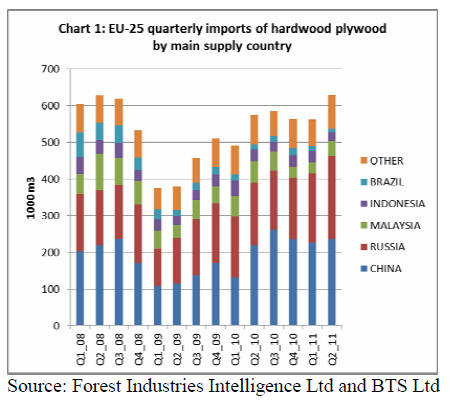
Much of the increase in EU hardwood plywood imports
consisted of birch plywood from Russia. EU imports of
hardwood plywood from Russia reached 416,000 cu.m in
the first half of 2011, up 23% from 340,000 cu.m in the
same period last year.
EU imports of hardwood plywood from China were up
32% at 464,000 cu.m in the first 6 months of this year.
However on a quarterly basis, imports from China have
been slipping since reaching a peak in the third quarter of
2010 and China¡¯s share of overall EU imports has been
falling relative to Russia during 2011.
However, there is little direct competition between
Russian and Chinese plywood in the EU market since
most Chinese plywood is destined for the UK and Belgium
while Russian plywood is sold primarily to Germany,
Finland, the Baltic countries and Italy.
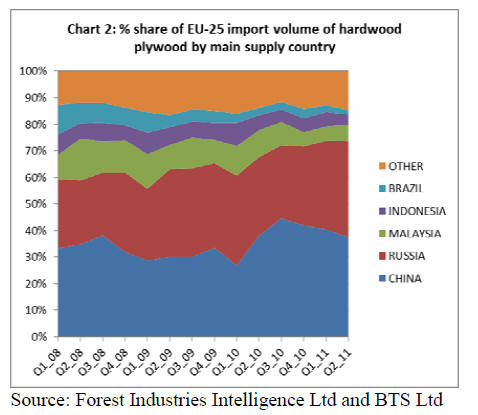
EU imports of hardwood plywood from the major tropical
producers have continued to decline this year. During the
first 6 months of 2011, imports from Malaysia were
69,000 cu.m, down nearly 40% on the same period of
2010.
Imports from Indonesia were down 28% at 55,000 cu.m,
and imports from Brazil reached only 24,000 cu.m, down
25%. Over the last 3 years, the share of these three
countries in overall EU hardwood plywood imports has
slipped from 28% to 12%.
European plywood market prospects set to deteriorate
There is little prospect of any significant improvement in
hardwood plywood market conditions during the rest of
the year says an analyst.
In their most recent plywood market report, the UK¡¯s TTJ
notes that forward purchasing was so limited over the
summer that the large regular monthly break-bulk
shipment from China to the UK for August was cancelled.
Furthermore, plywood trading has been very slow to pick
up in September and UK stocks of most qualities of
plywood are already considered sufficient to satisfy
demand for some weeks to come.
In fact many UK importers have more inventory of
Chinese hardwood plywood than they would like and
prices for onward sales in the UK have been weakening.
This is occurring even while CIF prices for Chinese
plywood have continued to firm in response to the
escalating costs of poplar veneer in China.
TTJ comment that Chinese plywood now dominates the
lower end of the UK plywood market and that its impact is
extending into the top end. Its presence has led to reduced
price expectations in the UK market as a whole and made
it more difficult for Malaysia¡¯s exporters to obtain a
margin that amply reflects the higher quality on offer.
The latest plywood market report by Germany-based
EUWID notes that demand for all types of Chinese
plywood has also been quiet in mainland Europe in recent
weeks with only occasional signs of a higher rate of top-up
purchases during September.
Although mainland European stocks of Chinese plywood
are low at present, the imminent arrival of some fairly
large shipments delayed from July and August are
expected to be sufficient to avoid any shortfalls in supply
in the last quarter of the year.
EUWID also note that demand for Indonesia and
Malaysian plywood in mainland Europe declined
significantly in July and August.
Furthermore plywood bought from Malaysia and
Indonesian mills at the end of September is unlikely to
reach importers before the end of November when
consumption is likely to be low and declining. Therefore
importers are already trying to avoid any build-up of
stocks at the end of the year as a reason to curtail forward
purchases.
Some importers say that tight margins and lower price
expectations in the plywood market driven partly by
China¡¯s large presence in the European market is now
pushing some shippers in Malaysia to compromise on
quality.
Unease deepens over European economic outlook
Clear signs of increasingly cautious buying of both
hardwood plywood and lumber by European importers
emerged during September. Underlying this trend is
deepening unease over the immediate prospects for the
European economy. Since their return from summer
vacations in August, European traders have been hit by a
wave of gloomy news.
In a recent report on the euro-zone¡¯s ¡°flagging economy¡±,
The Economist suggests that the region is caught in ¡°a
vicious feedback loop between growth, sovereign-debt
concerns and banking woes¡±. At the start of 2011, there
was confidence that a surging recovery in the euro-zone,
led by Germany, would enable the region to withstand the
debt crises that is now threatening to engulf Greece.
However, between the first and second quarters of 2011,
GDP growth fell sharply from 0.8% to 0.2% across the
euro-region and from 1.3% to 0.1% in Germany.
Slower growth across the euro-zone will make it even
more difficult for governments to hit their fiscal targets. It
implies that austerity measures will be even deeper and
more painful than expected.
The rising risk of recession is also likely to damage
Europe¡¯s fragile banking sector which already faces,
according to the IMF, potential losses of around $200
billion from higher risk on sovereign debt.
Under these circumstances, there seems little prospect of
any easing in the extremely tight credit available to
smaller firms ¨C including those in the wood sector ¨C which
has been impeding private sector growth over the last 3
years. And as growth stalls, it becomes even trickier for
increasingly unpopular politicians to convince European
tax payers to reach deeper into their pockets to rescue the
struggling euro.
Prospects seem little better outside the euro-zone at
present. On 20 September, the IMF reduced its forecast for
UK GDP growth to just 1.1% in 2011 compared to 1.7%
forecast in April. IMF now predicts the UK economy will
grow by only 1.6% in 2012 compared to 2.3% in the
previous forecast.
European Forest Sector Outlook study
The United Nations Economic Commission for Europe
(UNECE) and the Food and Agriculture Organisation
(FAO) have jointly released a comprehensive and farreaching
analysis of the outlook for the European forest
sector over the next 20 years.
Using computer modelling techniques and the best
available economic, forest inventory and trade data, the
¡°European Forest Sector Outlook Study II 2010-2030¡±
considers the impact of various policy scenarios.
The study suggests that Europe will remain, in all
scenarios, a net exporter of wood and forest products.
Significant net exports of wood products will continue to
outweigh relatively minor net imports even if demand for
the latter increases substantially in order to achieve
ambitious renewable energy targets.
The study's projections also show a steady rise in prices of
forest products and wood over the whole period, driven by
expanding global demand and increasing scarcity in
several regions.
The study compares various alternative policy scenarios
against a reference "business-as-usual" scenario (see
following graphic).
In this scenario, consumption of forest products and wood
energy is projected to grow steadily and wood supply to
expand to meet this demand, from around 970 million
cu.m RWE in 2010 to 1180 million cu.m RWE in 2030.
All components of supply will have to expand, especially
harvest residues.
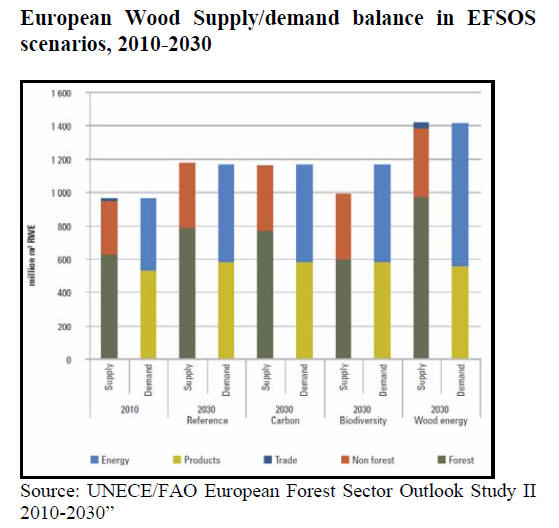
The ¡°maximising biomass carbon¡± scenario explores how
much carbon could be stored in the European forest by
changing silvicultural methods while not affecting the
level of harvest. It concludes that the forest sector¡¯s
contribution to carbon storage may be maximised in the
medium term by combining longer forestry rotations and a
greater share of forest thinnings to provide a steady flow
of wood for products and energy.
In the long term however, the sequestration capacity limit
of the forest will be reached, and the only potential for
further mitigation will be more regular harvesting to store
the carbon in harvested wood products and also avoiding
emissions from non-renewable materials and energy
sources.
The ¡°Priority to biodiversity¡± scenario assumes that
decision makers give priority to the protection of
biological diversity. The study concludes that this would
lead to 12% less wood production than the ¡°Business-asusual¡±
scenario.
It would necessitate reduced consumption of wood
products and energy, and/or increased imports from other
regions and/or intensified use of other sources like
landscape care wood and wood originating from
conservation management and short-rotation coppice.
The ¡°Promoting wood energy¡± scenario explores what
would be necessary for wood to contribute to achieving
the ambitious targets for renewable energies adopted by
most European countries. The study concludes that this
would require supply to increase by nearly 50% in twenty
years through strong mobilisation of all types of wood.
Such a mobilisation would have significant environmental,
financial and institutional costs. For example, it would be
necessary to expand areas of short rotation coppice on
agricultural land with potential loss of food production
capacity.
The study also reviews the sustainability implications of
all the scenarios. It concludes that for most indicators of
sustainability the outcome is "relatively satisfactory". The
main concern is for biodiversity, as increased harvest
pressure in all scenarios, except for the ¡°Priority to
biodiversity¡± scenario, lowers the amount of deadwood
and reduces the share of old stands.
The ¡°Promoting wood energy¡± scenario shows a decline in
sustainability with regards to forest resources and carbon,
due to the heavy pressure of increased wood extraction to
meet the renewable energy targets.
More details at:
http://www.unece.org/press/pr2011/11tim_p06e.html
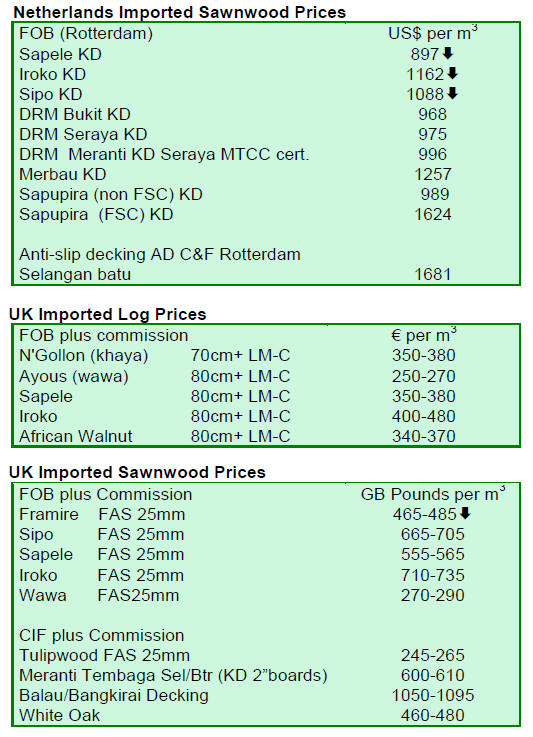
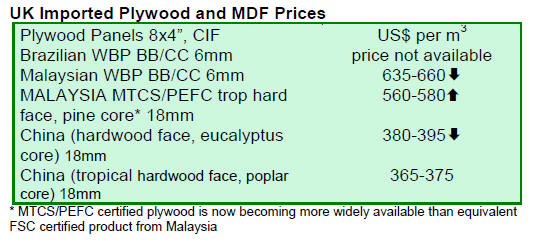 Related News:
|